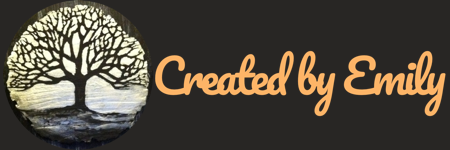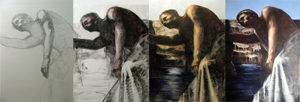It’s easy to take a painting for granted. When looking at a canvas our mind tells us that we see something three dimensional instead of the flat, two-dimensional surface it was painted on. As a viewer we automatically know it isn’t a real object. Cats will bat at television screens and birds will attack their own reflection. It’s rather amazing that people ever came to understand how to make and interpret paintings and that the ability to do so was actually quite sophisticated. Before all of those thoughts was my initial appreciation of a painting.
Loving a painting wasn’t unlike loving a book for me. It was a media that allowed me to go to another place, to someone else’s story. It wasn’t long before I was thinking of stories of my own and wanted to share what I thought or how I felt, even if the concept wasn’t easily put into words. I’ve always wanted someone to see my work and go to the same emotional state or quiet epiphany I had which lead me to those strokes. It was a hurried state I was in for years, feeling the rush to produce many paintings and the the hurt that followed because someone couldn’t identify a key item or had interpreted my work in an entirely different manner. It was an insult when they read my work another way and it sat on my shoulders like a failure.
I was learning about other forms of art, such as poetry, which told me that a writer can create a million pieces of work but the individual who views it will always bring their own interpretation. It wasn’t about being wrong or right, only having a solid reason for believing what you did. I couldn’t stop my viewers from seeing what they saw anymore than I could go back and change their life experiences and what they thought about clouds. Fifty percent of a painting was me and the other fifty percent was the viewer, bringing themselves to the table. Once I had that realization I learned the importance of getting input from multiple sources. If my sister and mother both thought the same area needed work that was where I focused. I still show them my work to see how they react– it’s never predictable. The best judge for my artwork was someone who wasn’t an artist because artists weren’t the ones buying my work (generally speaking!). Artists might have been able to appreciate more traditional methods of painting, how difficult certain media is to work with or that I incorporate contrapposto in my painting to enhance the Greek/Roman feel, but even someone untrained in the history or terminology of art would seen it. I’ve been told that my best work “feels right” when they look at it, which along with “Ooooo… I like that” is the highest compliment I can receive.
After awhile it wasn’t just about the idea or final production of a piece that captured my interest. I noticed that when friends came to visit that they had a keen interest not just in my finished work, but in my artworks in progress. They told me it was interesting to see the changes that happened over time as I developed a piece. I found I could relate to that feeling– I would have given anything to see Picasso or Monet create a painting. Though I’m not on the level of any of the great masters I could understand the interest and fun in watching a piece of art develop from a sketch into a finished work. Below is an image of one of my mythology paintings, Tantalus. I took pictures at for “pivotal” points during its production. For some people watching this transition is more meaningful than the work itself! My next commission coming up is to paint a mural and I have been given permission to video tape the production of the work. I hope that you find it to be an entertaining watch! I’ve never seen a video of myself painting, nor have I ever taken one, so I am hoping that the result is good.
Sometimes I think that I’m glad I’m not a bird or cat. Much of what I love is seeing things that aren’t there and then giving them to other people.

